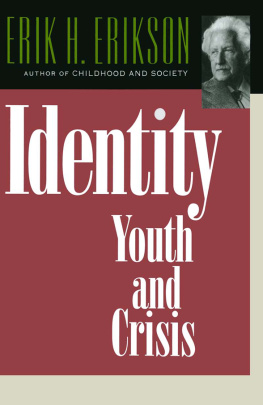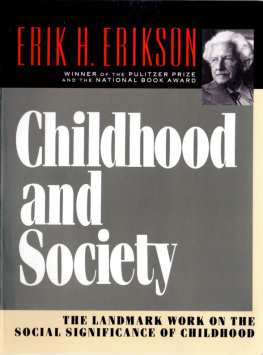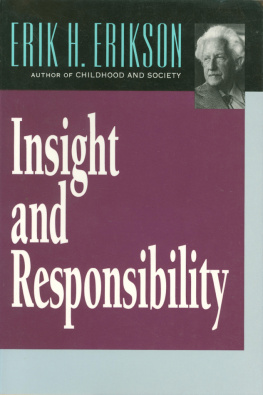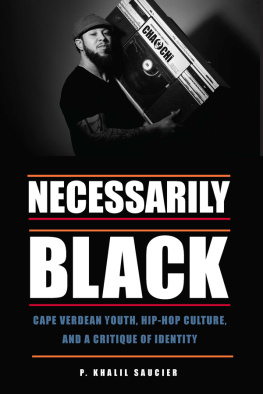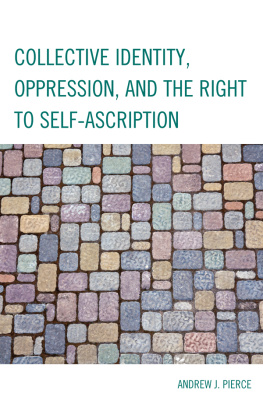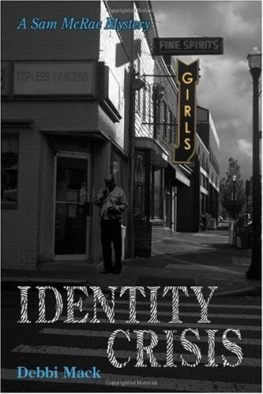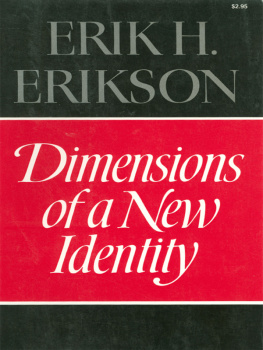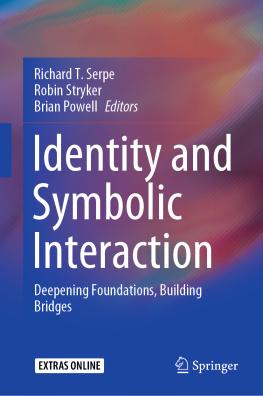
Identity
Youth and Crisis
Identity
Youth and Crisis
BY ERIK H. ERIKSON
Childhood and Society (1950, 1963)
Young Man Luther (1958)
Insight and Responsibility (1964)
Identity: Youth and Crisis (1968)
Gandhis Truth (1969)
Dimensions of a New Identity (1974)
Life History and the Historical Moment (1975)
Toys and Reasons (1977)
Identity and the Life Cycle (1959, 1980)
The Life Cycle Completed (1982)
Vital Involvement in Old Age (with Joan M. Erikson and
Helen Q. Kivnick) (1986)
A Way of Looking at Things: Selected Papers
from 1930 to 1980 (edited by Stephen Schlein, Ph.D.) (1987)
EDITED BY ERIK H. ERIKSON
Adulthood (1978)
CHAPTER I. Transcript of a Workshop on Identity, San Francisco Psychoanalytic Institute (1966). Letter to the Committee on the Year 2000 (1967).
CHAPTER II. Ego Development and Historical Change (1946). On the Sense of Inner Identity (1951). Wholeness and Totality (1954).
CHAPTER III. Growth and Crises of the Healthy Personality (1950).
CHAPTER IV. The Problem of Ego Identity (1956). The Dream Specimen of Psychoanalysis (1954). The Syndrome of Identity Confusion (1955). Ego Identity and the Psychosocial Moratorium (1956). Preface to Emotional Problems of the Student (1961).
CHAPTER V. The Problem of Ego Identity (1956) and unpublished notes.
CHAPTER VI. Youth: Fidelity and Diversity (1962).
CHAPTER VII. The Inner and the Outer Space: Reflections on Womanhood (1964).
CHAPTER VIII. The Concept of Identity in Race Relations (1966).
Reissued as a Norton paperback 1994
Copyright 1968 by
W. W. Norton & Company, Inc.
Austen Riggs Monograph No. 7
Library of Congress Catalog Card No. 67-17681
ISBN 978-0-393-34734-0 (e-book)
W. W. Norton & Company, Inc.
500 Fifth Avenue, New York, N.Y. 10110
www.wwnorton.com
W. W. Norton & Company Ltd.
Castle House, 75/76 Wells Street, London WIT 3QT
TO THE MEMORY OF
Robert P. Knight AND David Rapaport
Contents
TO REVIEW THE CONCEPT OF IDENTITY means to sketch its history. In the twenty years since the term was first employed in the particular sense to be discussed in this book, its popular usage has become so varied and its conceptual context so expanded that the time may seem to have come for a better and final delimitation of what identity is and what it is not. And yet, by its very nature, what bears such a definitive name remains subject to changing historical connotations.
Identity and identity crisis have in popular and scientific usage become terms which alternately circumscribe something so large and so seemingly self-evident that to demand a definition would almost seem petty, while at other times they designate something made so narrow for purposes of measurement that the over-all meaning is lost, and it could just as well be called something else. If, to give examples of the wider use of the term, the papers run a headline The Identity Crisis of Africa or refer to the identity crisis of the Pittsburgh glass industry; if the outgoing president of the American Psychoanalytic Association titles his farewell address The Identity Crisis of Psychoanalysis; or if, finally, the Catholic students at Harvard announce that they will hold an Identity Crisis on Thursday night at eight oclock sharp, then the dignity of the term seems to vary greatly. The quotation marks are as important as the term they bracket: everybody has heard of identity crisis and it arouses a mixture of curiosity, mirth, and discomfort which yet promises, by the very play on the word crisis, not to turn out to be something quite as fatal as it sounds. In other words, a suggestive term has begun to lend itself to ritualized usage.
Social scientists, on the other hand, sometimes attempt to achieve greater specificity by making such terms as identity crisis, self-identity, or sexual identity fit whatever more measurable item they are investigating at a given time. For the sake of logical or experimental maneuverability (and in order to keep in good academic company) they try to treat these terms as matters of social roles, personal traits, or conscious self-images, shunning the less manageable and more sinisterwhich often also means the more vitalimplications of the concept. Such usages have, in fact, become so indiscriminate that the other day a German reviewer of the book in which I first used the term in the context of psychoanalytic ego theory called it the pet subject of the amerikanische Populaerpsychologie.
But one may note with satisfaction that the conceptualization of identity has led to a series of valid investigations which, if they do not make clearer what identity is, nevertheless have proved useful in social psychology. And it may be a good thing that the word crisis no longer connotes impending catastrophe, which at one time seemed to be an obstacle to the understanding of the term. It is now being accepted as designating a necessary turning point, a crucial moment, when development must move one way or another, marshaling resources of growth, recovery, and further differentiation. This proves applicable to many situations: a crisis in individual development or in the emergence of a new elite, in the therapy of an individual or in the tensions of rapid historical change.
The term identity crisis was first used, if I remember correctly, for a specific clinical purpose in the Mt. Zion Veterans Rehabilitation Clinic during the Second World War, a national emergency which permitted psychiatric workers of different persuasions and denominations, among them Emanuel Windholz and Joseph Wheelwright, to work together harmoniously. Most of our patients, so we concluded at that time, had neither been shellshocked nor become malingerers, but had through the exigencies of war lost a sense of personal sameness and historical continuity. They were impaired in that central control over themselves for which, in the psychoanalytic scheme, only the inner agency of the ego could be held responsible. Therefore, I spoke of a loss of ego identity. 1 Since then, we have recognized the same central disturbance in severely conflicted young people whose sense of confusion is due, rather, to a war within themselves, and in confused rebels and destructive delinquents who war on their society. In all these cases, then, the term identity confusion has a certain diagnostic significance which should influence the evaluation and treatment of such disturbances. Young patients can be violent or depressed, delinquent or withdrawn, but theirs is an acute and possibly passing crisis rather than a breakdown of the kind which tends to commit a patient to all the malignant implications of a fatalistic diagnosis. And as has always been the case in the history of psychoanalytic psychiatry, what was first recognized as the common dynamic pattern of a group of severe disturbances (such as the hysterias of the turn of the century) revealed itself later to be a pathological aggravation, an undue prolongation of, or a regression to, a normative crisis belonging to a particular stage of individual development. Thus, we have learned to ascribe a normative identity crisis to the age of adolescence and young adulthood.
Referring to the first use of the term identity crisis, I said if I remember correctly. Perhaps one should be able to remember such things. But the fact is that a term which later becomes so distinctive is often first used as something one takes, and thinks others take, for granted. This brings to mind one of the innumerable stories with which Norman Reider could be counted on to lighten those often weary war days. An old man, he recounted, used to vomit every morning, but he showed no inclination to consult a doctor about it. His family finally prevailed on him to go to Mt. Zion for a general checkup. When Dr. Reider approached him cautiously, How are you? he was told promptly, Im fine. Couldnt be better. And, indeed, on further examination the constituent parts of the old man seemed to be in as good shape as could be expected. Finally, Dr. Reider became a bit impatient. But I hear you vomit every morning? The old man looked mildly surprised and said, Sure. Doesnt everybody?
Next page
